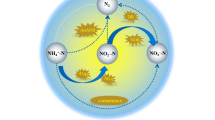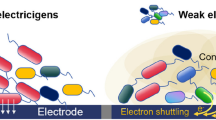Abstract
In this study, an anaerobic batch experiment was conducted to investigate the humus- and Fe(III)-reducing ability of a novel humus-reducing bacterium, Thauera humireducens SgZ-1. Inhibition tests were also performed to explore the electron transport pathways with various electron acceptors. The results indicate that in anaerobic conditions, strain SgZ-1 possesses the ability to reduce a humus analog, humic acids, soluble Fe(III), and Fe(III) oxides. Acetate, propionate, lactate, and pyruvate were suitable electron donors for humus and Fe(III) reduction by strain SgZ-1, while fermentable sugars (glucose and sucrose) were not. UV-visible spectra obtained from intact cells of strain SgZ-1 showed absorption peaks at 420, 522, and 553 nm, characteristic of c-type cytochromes (cyt c). Dithionite-reduced cyt c was reoxidized by Fe-EDTA and HFO (hydrous ferric oxide), which suggests that cyt c within intact cells of strain SgZ-1 has the ability to donate electrons to extracellular Fe(III) species. Inhibition tests revealed that dehydrogenases, quinones, and cytochromes b/c (cyt b/c) were involved in reduction of AQS (9, 10-anthraquinone-2-sulfonic acid, humus analog) and oxygen. In contrast, only NADH dehydrogenase was linked to electron transport to HFO, while dehydrogenases and cyt b/c were found to participate in the reduction of Fe-EDTA. Thus, various different electron transport pathways are employed by strain SgZ-1 for different electron acceptors. The results from this study help in understanding the electron transport processes and environmental responses of the genus Thauera.







Similar content being viewed by others
References
Bird LJ, Bonnefoy V, Newman DK (2011) Bioenergetic challenges of microbial iron metabolism. Trends Microbiol 19:330–340
Bretschger O, Obraztsova A, Sturm CA, Chang IS, Gorby YA, Reed SB, Culley DE, Reardon CL, Barua S, Romine MF, Zhou J, Beliaev AS, Bouhenni R, Saffarini D, Mansfeld F, Kim BH, Fredrickson JK, Nealson KH (2007) Current production and metal oxide reduction by Shewanella onedensis MR-1 wild type and mutants. Appl Environ Microbiol 73:7003–7012
Carlson HK, Iavarone AT, Gorur A, Yeo BS, Tran R, Melnyk RA, Mathies RA, Auer M, Coates JD (2012) Surface multiheme c-type cytochrome from Thermincola potens and implications for respiratory metal reduction by gram-positive bacteria. Proc Natl Acad Sci U S A 109:1702–1707
Collins ML, Niederman RA (1976) Membranes of Rhodospirilium rubrum: isolation and physicochemical properties of membranes from aerobically grown cells. J Bacteriol 126:1316–1325
D’Orazio V, Senesi N (2009) Spectroscopic properties of humic acids isolated from the rhizosphere and bulk soil compartments and fractionated by size-exclusion chromatography. Soil Biol Biochem 41:1775–1781
Francis CA, Obraztsova AY, Tebo BM (2000) Dissimilatory metal reduction by the facultative anaerobe Pantoea agglomerans SP1. Appl Environ Microbiol 60:543–548
Fredrickson JK, Gorby YA (1996) Environmental processes mediated by iron-reducing bacteria. Curr Opin Biotechnol 7:287–294
Gorby YA, Lovley DR (1991) Electron transport in the dissimilatory iron reducer, GS-15. Appl Environ Microbiol 57:867–870
Hernandez-Montoya V, Alvarez LH, Montes-Moran MA, Cervantes FJ (2012) Reduction of quinone and non-quinone redox functional groups in different humic acid samples by Geobacter sulfurreducens. Geoderma 183–184:25–31
Hunt KA, Flynn JM, Naranjo B, Shikhare ID, Gralnick JA (2010) Substrate-level phosphorylation is the primary source of energy conservation during anaerobic respiration of Shewanella oneidensis strain MR-1. J Bacteriol 192:3345–3351
Ingvorsen K, Zehnder AJ, Jorgensen BB (1984) Kinetics of sulfate and acetate uptake by Desulfobacter postgatei. Appl Environ Microbiol 47:403–408
Jiang K, Sanseverino J, Chauhan A, Lucas S, Copeland A, Lapidus A, Del Rio TG, Dalin EM, Tice H, Bruce D, Goodwin L, Pitluck S, Sims D, Brettin T, Detter JC, Han C, Chang YJ, Larimer F, Land M, Hauser L, Kyrpides NC, Mikhailova N, Moser S, Jegier P, Close D, Debruyn JM, Wang Y, Layton AC, Allen MS, Sayler GS (2012) Complete genome sequence of Thauera aminoaromatica strain MZ1T. Stand Genomic Sci 6:325–335
Kaufmann F, Lovley DR (2001) Isolation and characterization of a soluble NADPH-dependent of Fe(III) reductase from Geobaccter sulfurreducens. J Bacteriol 183:4468–4476
Knight VV, Blakemore R (1998) Reduction of diverse electron acceptors by Aeromonas hydrophila. Arch Microbiol 169:239–248
Liu C, Zachara JM, Foster NS, Strickland J (2007) Kinetics of reductive dissolution of hematite by bioreduced anthraquinone-2,6-disulfonate. Environ Sci Technol 41:7730–7735
Liu G, Zhou J, Wang J, Wang X, Jin R, Lv H (2011a) Decolorization of azo dyes by Shewanella oneidensis MR-1 in the presence of humic acids. Appl Microbiol Biotechnol 91:417–424
Liu T, Li X, Li F, Zhang W, Chen M, Zhou S (2011b) Reduction of iron oxides by Klebsiella pneumoniae L17: kinetics and surface properties. Colloid Surface A 379:143–150
Liu B, Frostegard A, Shapleigh JP (2013) Draft genome sequences of five strains in the genus Thauera. Genome Announc 1: doi:10.1128/genomeA.00052-12
Lovley DR, Coates JD, Blunt-Harris EL, Phillips EJP, Woodward JC (1996) Humic substances as electron acceptors for microbial respiration. Nature 382:445–448
Lowe EC, Bydder S, Hartshorne RS, Tape HL, Dridge EJ, Debieux CM, Paszkiewicz K, Singleton I, Lewis RJ, Santini JM, Richardson DJ, Butler CS (2010) Quinol-c-type cytochrome oxidoreductase and cytochrome c4 mediate electron transfer during selenate respiration in Thauera selenatis. J Biol Chem 285:18433–18442
Macy JM, Rech S, Auling G, Dorsch M, Stackebrandt E, Sly LI (1993) Thauera selenatis gen. nov., sp. nov., a member of the beta subclass of Proteobacteria with a novel type of anaerobic respiration. Int J Syst Bacteriol 43:135–142
Martinez CM, Alvarez LH, Cells LB, Cervantes FJ (2013) Humus-reducing microorganisms and their valuable contribution in environmental process. Appl Microbiol Biotechnol 97:10293–10308
Myers CR, Myers JM (1992) Localization of cytochromes to the outer membrane of anaerobically grown Shewanella putrefaciens MR-1. J Bacteriol 174:3429–3438
Park DH, Kim BH (2001) Growth properties of the iron-reducing bacteria, Shewanella putrefaciens IR-1 and MR-1 coupling to reduction of Fe(III) to Fe(II). J Microbiol 39:273–278
Ratasuk N, Nanny MA (2007) Characterization and quantification of reversible redox sites in humic substances. Environ Sci Technol 41:7844–7850
Rosenbaum MA, Bar HY, Beg QK, Segre D, Booth J, Cotta MA, Angenent LT (2012) Transcriptional analysis of Shewanella oneidensis MR-1 with an electrode compared to Fe(III)citrate or oxygen as terminal electron acceptor. PLoS ONE 7:doi:10.1371/journal.pone.0030827
Shi L, Rosso KM, Clarke TA, Richardson DJ, Zachara JM, Fredrickson JK (2012) Molecular underpinnings of Fe(III) oxide reduction by Shewanella oneidensis MR-1. Front Microbiol 3:50. doi:10.3389/fmicb.2012.00050
Straub KL, Kappler A, Schink B (2005) Enrichment and isolation of ferric-iron- and humic-acid-reducing bacteria. Methods Enzymol 397:58–77
Thomas PE, Ryan D, Levin W (1976) An improved staining procedure for the detection of the peroxidase activity of cytochrome P-450 on sodium dodecyl sulfate polyacrylamide gels. Anal Biochem 75:168–176
Van Trump JI, Sun Y, Coates JD (2006) Microbial interactions with humic substances. Adv Appl Microbiol 60:55–96
Wolf M, Kappler A, Jiang J, Meckenstock RU (2009) Effects of humic substances and quinones at low concentrations on ferrihydrite reduction by Geobacter metallireducens. Environ Sci Technol 43:5679–5685
Woznica A, Dzirba J, Manka D, Labuzek S (2003) Effects of electron transport inhibitors on iron reduction in Aeromonas hydrophila strain KB1. Anaerobe 9:125–130
Wu CY, Zhuang L, Zhou SG, Li FB, Li XM (2010) Fe(III)-enhanced anaerobic transformation of 2,4-dichlorophenoxyacetic acid by an iron-reducing bacterium Comamonas koreensis CY01. FEMS Microbiol Ecol 71:106–113
Wu CY, Zhuang L, Zhou SG, Yuan Y, Yuan T, Li FB (2013) Humic substance-mediated reduction of Fe(III) oxide and degradation of 2,4-D by an alkaliphilic bacterium Corynebacterium humireducens MFC-5. Microb Biotechnol 6:141–149
Yang GQ, Zhang J, Kwon SW, Zhou SG, Han LC, Chen M, Ma C, Zhuang L (2013) Thauera humireducens sp. nov., a humus-reducing bacterium isolated from a microbial fuel cell. Int J Syst Evol Microbiol 63:873–878
Yuan T, Yuan Y, Zhou SG, Li FB, Liu Z, Zhuang L (2011) A rapid and simple electrochemical method for evaluating the electron transfer capacities of dissolved organic matter. J Soils Sediments 11:467–473
Acknowledgments
This research was supported by the National Natural Science Foundation of China (Nos. 41201227; 41401270).
Author information
Authors and Affiliations
Corresponding author
Rights and permissions
About this article
Cite this article
Ma, C., Yu, Z., Lu, Q. et al. Anaerobic humus and Fe(III) reduction and electron transport pathway by a novel humus-reducing bacterium, Thauera humireducens SgZ-1. Appl Microbiol Biotechnol 99, 3619–3628 (2015). https://doi.org/10.1007/s00253-014-6254-x
Received:
Accepted:
Published:
Issue Date:
DOI: https://doi.org/10.1007/s00253-014-6254-x




